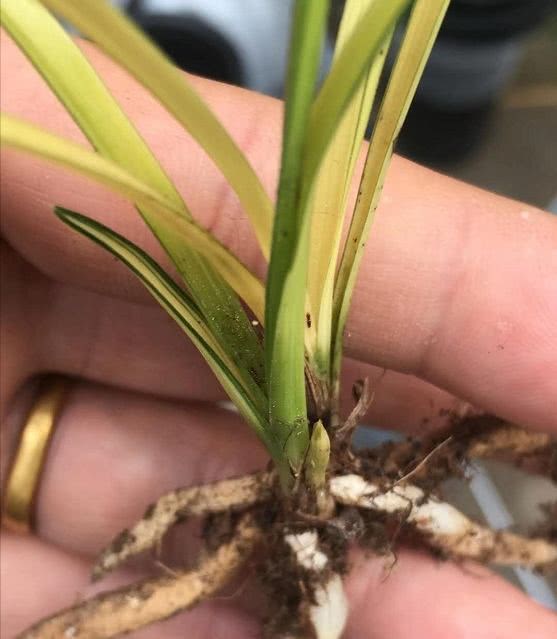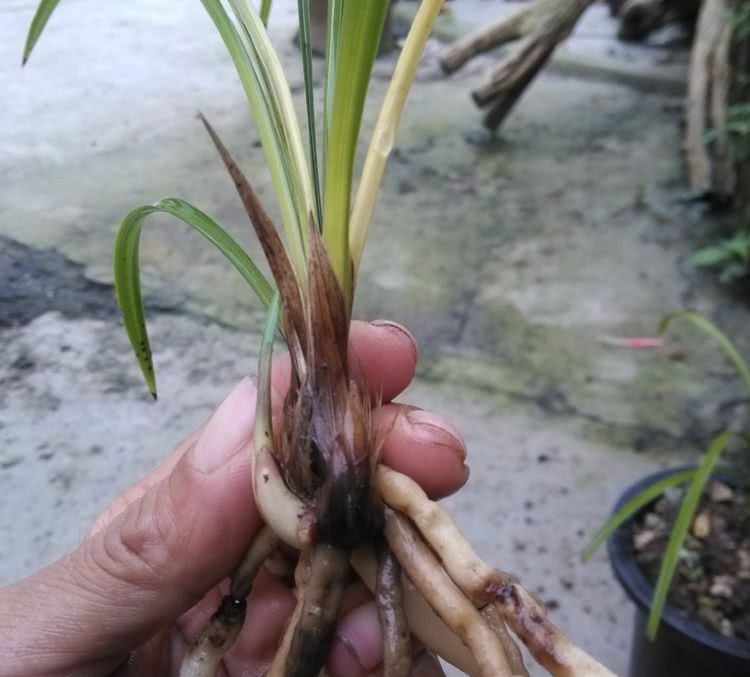The sixteen procedures of turning over pots and planting orchids will be easy to manage after making great efforts on the planting method.

Turning pot and planting orchid is the content that every orchid friend must operate, but because the operation procedure and order of each person are different, the result of orchid seedling management after planting is very different. My personal experience is that we should attach great importance to the process and sequence of planting, make efforts on the "planting method" and follow the guiding ideology of "seven-point planting and three-division management". If we are serious when planting, the future management will be simple. My specific actions are as follows:
First, take seedlings and wash them. After turning the basin to take out the orchid seedlings, rinse the whole orchid plant (including roots, stems and leaves) on the faucet.
Second, cool (sun) the seedlings. The orchid seedlings washed from the soil are tied to the orchid root with a string and hung upside down in a ventilated place (or in the sun) to cool (bask) for 2 hours (wait for the water vapor to dry the roots and soften).
Third, prepare disinfectant. Choose the pesticide you like to use to prepare disinfectant. When equipped, we must pay attention to two points: first, it is better to choose pesticides that can treat both fungi and bacteria as far as possible. Such as "can be killed", "Kobo" and so on; second, the dosage must be accurate. My method is powder pesticide with balance, water (milk) pesticide with medical syringe pumping, water dosage cup injection.
Fourth, ramet pruning. Take off the cool orchid clump to split and prune, and thoroughly remove rotten roots and diseased leaves (especially dry rot leaf beetles).
Fifth, choose a basin to prepare a prescription. After dividing the plants, one is to select the appropriate orchid basin according to the number of orchid seedlings and the length of the root system, and the other is to formulate the plant material formula according to the variety, seedling strength and root system.
Sixth, soak the seedlings for disinfection. Soak the ramet and pruned orchid seedlings in disinfectant solution, soak the root and stem for 30 minutes, and then soak the orchid leaves for 2 minutes. After soaking, rinse the liquid with clean water.
Apply powder and cool (sun) seedlings. Smear the seedlings with pesticides without internal absorption (such as daconine, chlorothalonil, etc.) or soot, trim the wound, and hang the roots upside down with string until the roots are dried by water vapor to soften.
Eighth, the amount of planting materials. Making use of the interval of immersion and disinfection of orchid seedlings, the total amount of pot materials was injected with the selected orchid basin, and then the proportion of various plant materials was calculated according to the above formula, and then the plant materials were prepared according to the prescription. My method is: first use the selected orchid basin to fill the general plant material (the old soil can be replaced by turning the basin), pour it into a large basin, with a large spoon weight. If the total amount of plant in the orchid basin is 10 tablespoons, the new material will be mixed according to the determined proportion of ingredients. If the formula is 60% (6 tablespoons) of chestnut leaves, 20% (2 tablespoons) of bark, 10% (1 tablespoon) of snake wood, and 10% (1 tablespoon) of red immortal soil.
9. Disinfection of plant materials. The prepared plant materials will be disinfected at high temperature. The method can be steamed and boiled. My method is to treat it in a microwave oven for 8 minutes. In the process of high temperature disinfection, depending on the situation, you can mainly deal with chestnut leaves, bark, snake wood and other plant materials that you think are susceptible to diseases and insect pests. Generally, the newly bought pond cornerstone, fairy soil and other granular materials do not need to be dealt with, but they can only be used after soaking for 1 min in advance for 2 days.
Disinfect orchid pots. The selected orchid basin is first rinsed with clean water, and then disinfected by soaking the orchid seedling with agricultural medicine solution.
11. Soak the moss in soft water first, then disinfect it with the plant material at high temperature and set it aside.
12. Pad the bottom of the basin. Use the right amount of plastic foam at the bottom before planting, or use the special plastic cover sold in the market to cover the bottom.
Thirteen, set the depth. When planting orchid, hold the seedling with one hand, set the deep position according to the orchid basin and seedling situation, generally take the false bulb to be about 2 cm higher than the edge of the pot.
Sift and plant at the same time. The plant material that has been sterilized and cooled at high temperature is poured into the sieve and planted while sieving, the coarse material on the sieve surface is collected and put into the bottom of the pot, the fine material in the sieve is placed on the pot surface, and the steamed bread is harvested.
Cover the water moss. After the plant material is filled and harvested in the shape of steamed bread, the water moss which is fully softened and sterilized at high temperature is evenly covered on the orchid basin to make it moisturizing, easy to water and beautiful.
Sixteen, pour the root water thoroughly. After high temperature disinfection, the plant materials not only fully killed the bacteria and eggs, but also killed the beneficial microorganisms beneficial to the orchid. At this time, using 500 times "blue fungus king" water to irrigate the fixed root water can supplement the beneficial microorganisms (blue bacteria) in the plant material in time and make the orchid root grow well. The time of watering the root water depends on the quality of the root system of the orchid clump (the size of the wound) and the degree of dryness and wetness of the plant material, which can be irrigated immediately or after 1 minute or 2 days.
After watering the fixed root water, the planting of the whole pot of orchids will only be completed after 16 processes, and the whole process will take about 5 mi 10 hours (for example, it takes 30 mi 40 hours to water the fixed roots every other day).
- Prev

The traditional method of anoxic decay of Langen is to turn over the basin of hydrogen peroxide to save the dying orchid.
In the process of orchid cultivation, the anoxic rot of orchid root is often caused by improper management, watering and fertilization. The traditional way to save the rotten roots of orchids is to turn over the pot and plant them, which is not only troublesome but also causes new damage to orchids.
- Next

Instead of facing the crowded scenic spot, I chose to take care of delicious meat at home during the seven-day National Day holiday.
Good evening, ladies and gentlemen. Did everyone eat moon cakes during the Mid-Autumn Festival? With a cloud leg moon cake in the left hand and a beloved peach egg in the right hand, there is a special taste when watching the moon. Just after the Mid-Autumn Festival, National Day is coming to report the annual National Day.
Related
- Wuhan Hospital Iron Tree Blooming Result Was Instantly Frightened by the Gardener Master
- Which variety of camellia is the most fragrant and best? Which one do you like best?
- What is the small blue coat, the breeding methods and matters needing attention of the succulent plant
- Dormancy time and maintenance management of succulent plants during dormancy
- Minas succulent how to raise, Minas succulent plant pictures
- What are the varieties of winter succulent plants
- How to raise succulent plants in twelve rolls? let's take a look at some experience of breeding twelve rolls.
- Attention should be paid to water control for succulent plants during dormant period (winter and summer)
- Watering experience of twelve rolls of succulent plants
- Techniques for fertilizing succulent plants. An article will let you know how to fertilize succulent plants.

